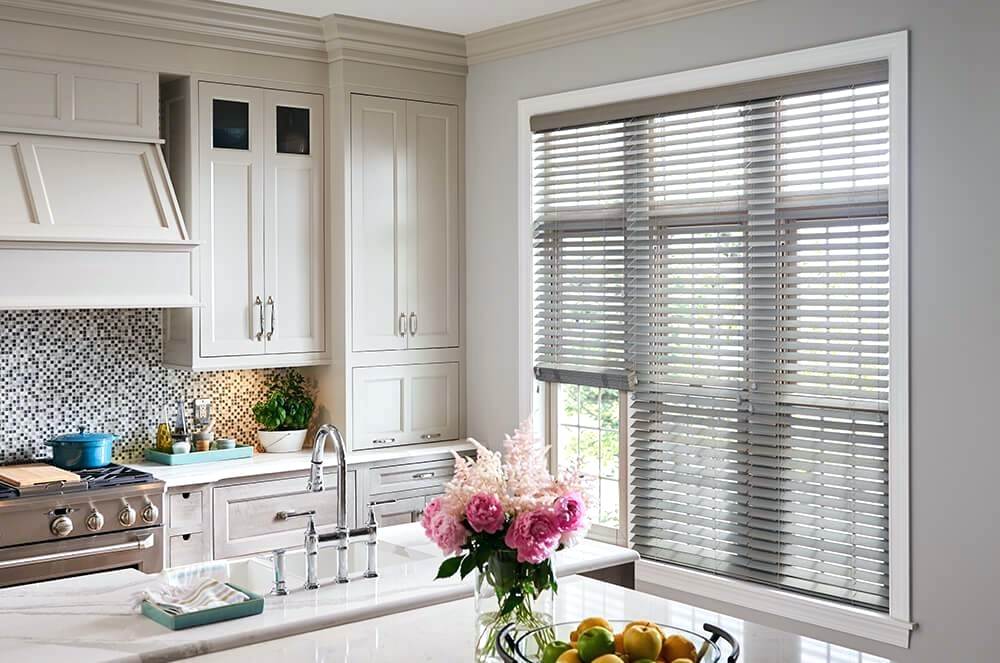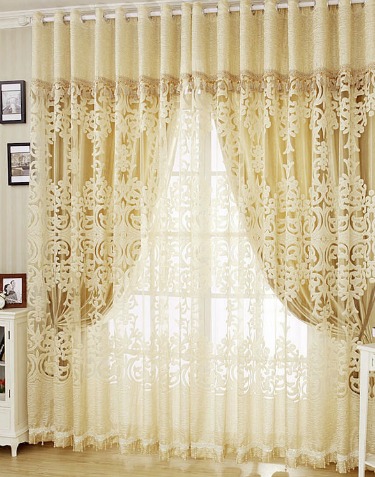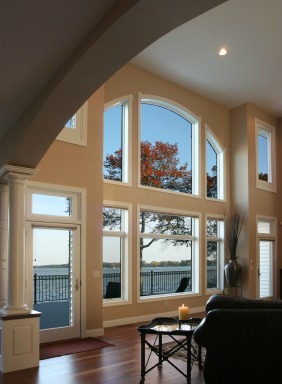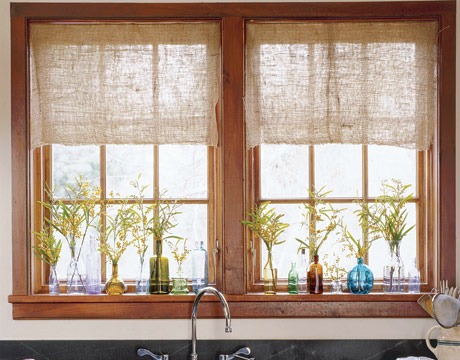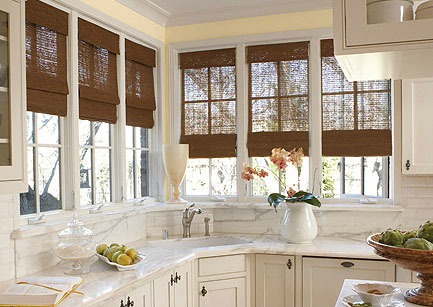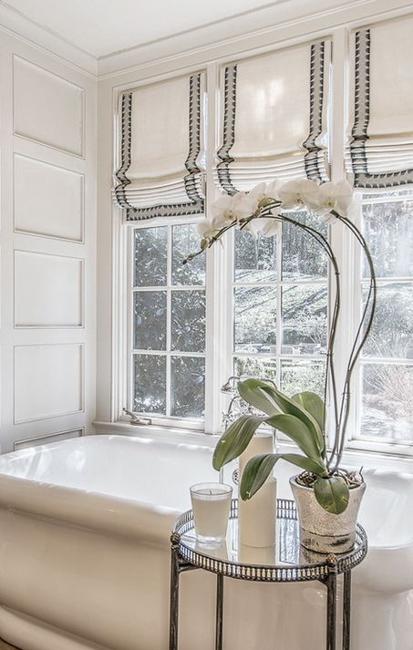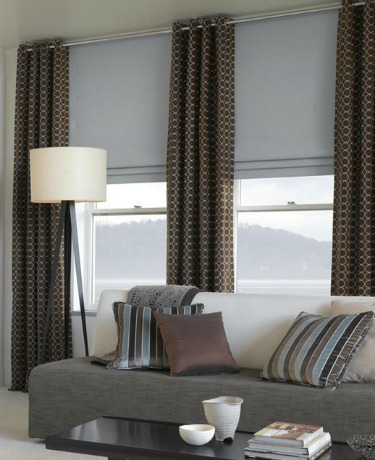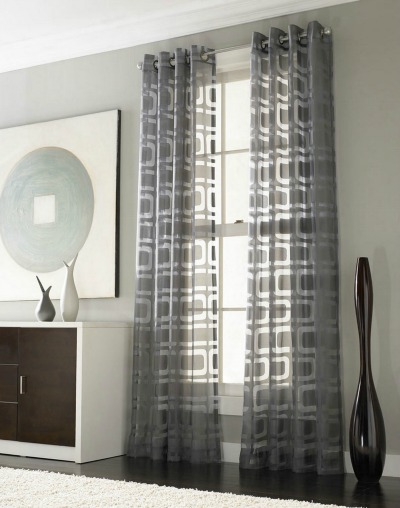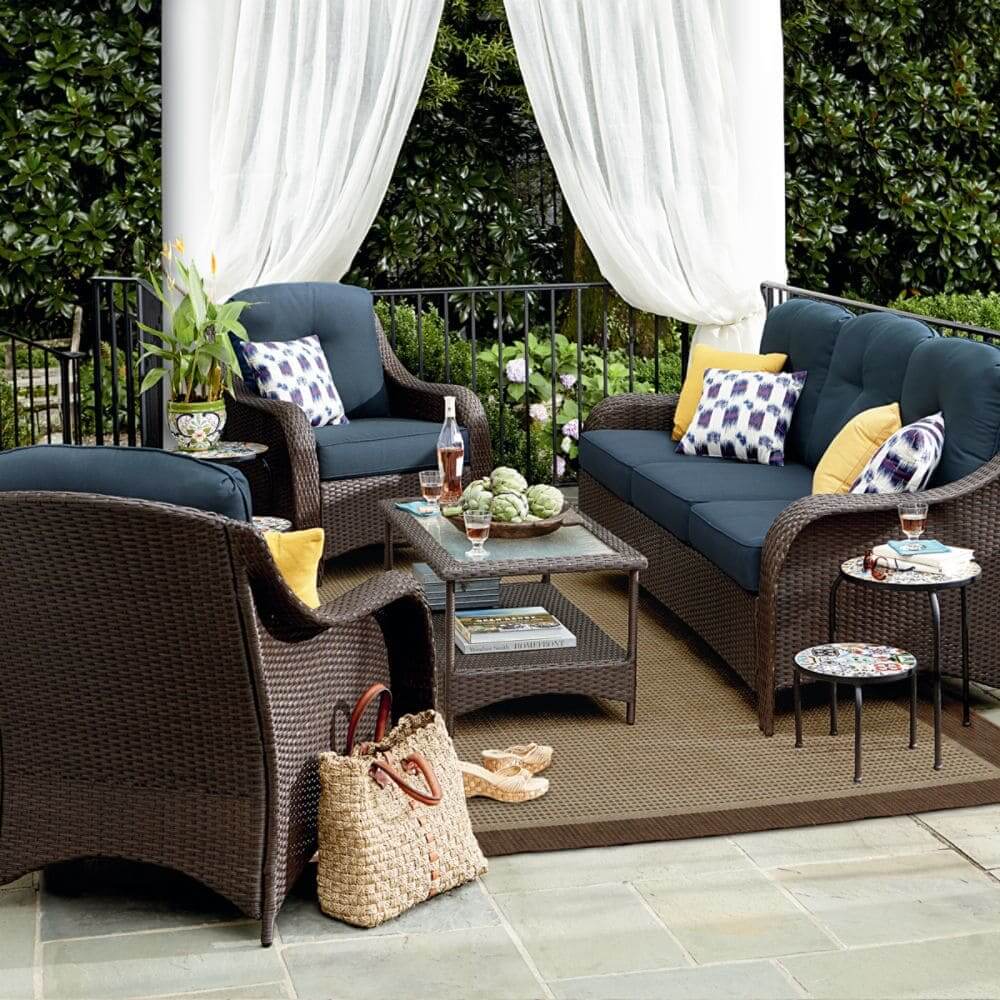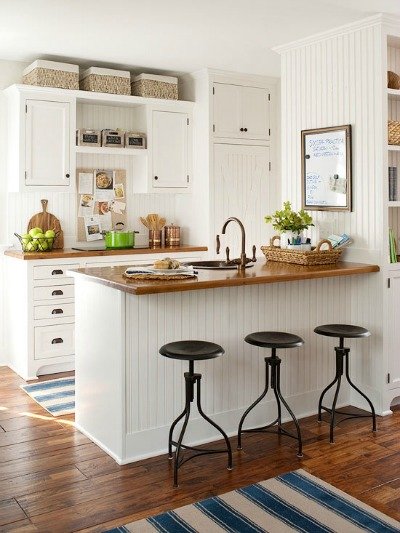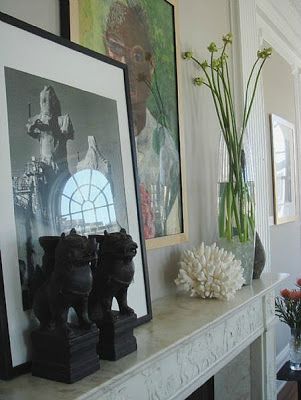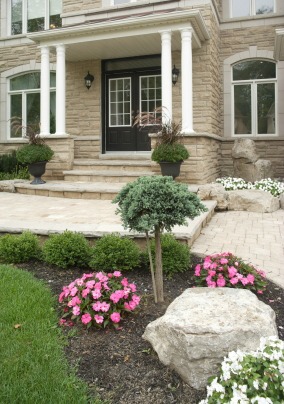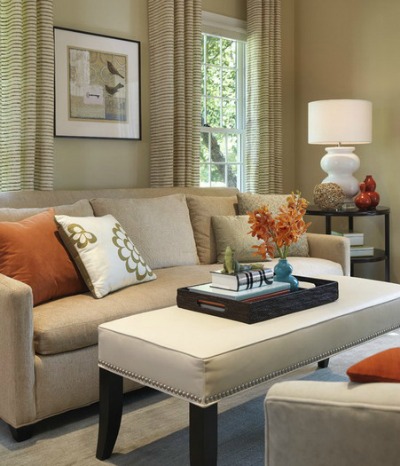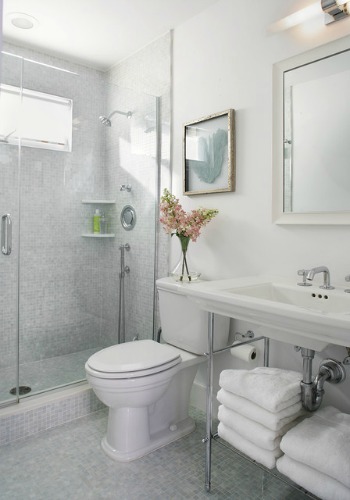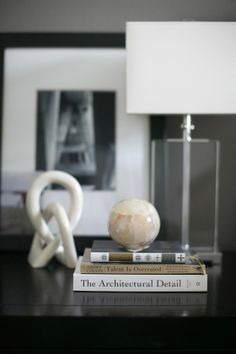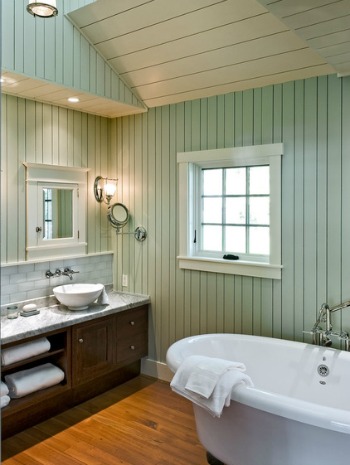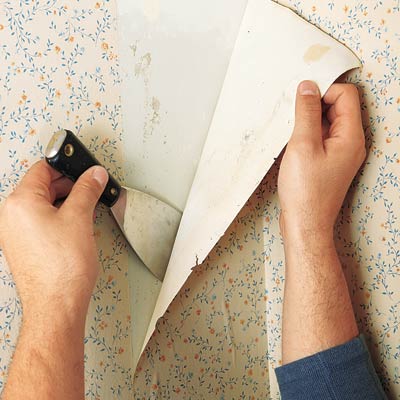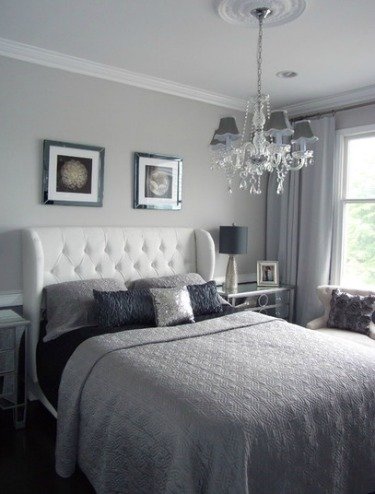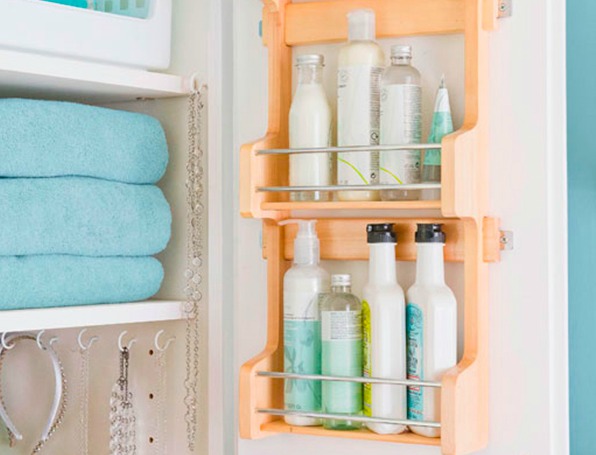Window Treatments for Home Staging
For a faster, more profitable home sale
Using the right kind of window treatments can help sell your home by emphasizing architectural details and soften the hard edges of a room. Good window decor can instantly improve the look and feel of a room-- sort of like accessorizing a favorite outfit.
Window treatments are also used to control light, create privacy, frame a view, add accent color or texture, and make a living space warm and inviting.
Home buyers today are looking for a home with plenty of natural light, which is the most important kind of lighting as it infuses a home with an expansive brightness.
If you're selling your home, be sure to install window treatments that're clean and contemporary in design. If you have a great view and privacy is not an issue, consider leaving windows bare, or go with sheer curtains.
Different styles of window treatments
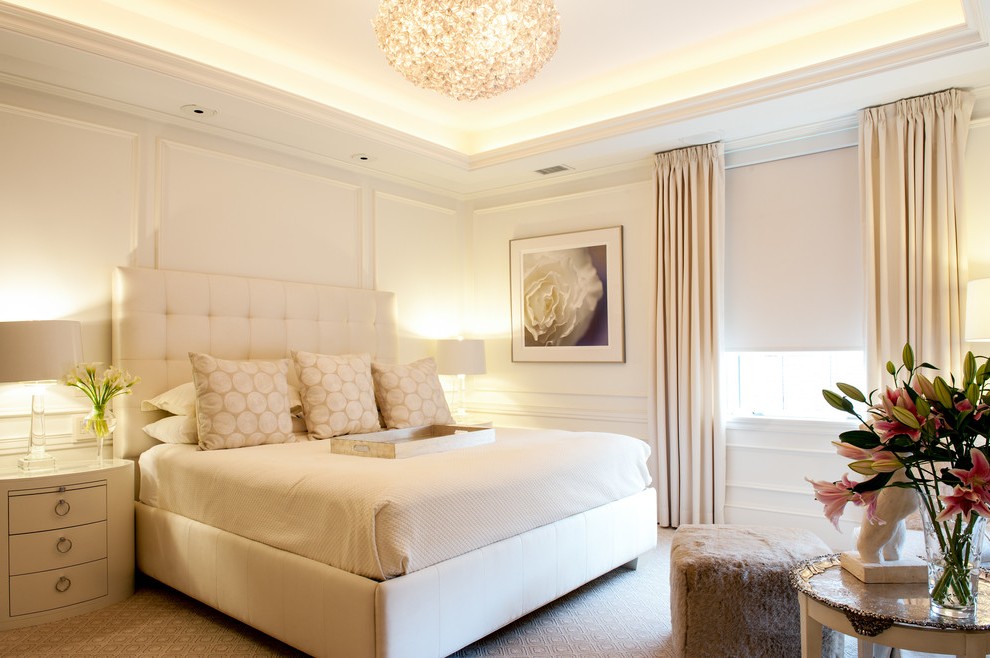 The window treatments in this monotone bedroom show how hard and soft window treatments complement each other.
The window treatments in this monotone bedroom show how hard and soft window treatments complement each other.Window coverings can be divided into two groups; soft and hard. Soft window treatments are made with fabric, of course. Examples are curtains, draperies, valances, roller shades, and roman blinds. Fabric draperies and curtains soften a room and make it more inviting.
Hard window treatments are made from a variety of different products; plastic, metal or wood. This includes blinds, shutters, screens, even specialty glass that may be frosted or stained. Hard and soft window treatments can be used alone or together to complement each other.
Take down outdated window treatments
If you're selling your home, you may want to update the look of your windows.
Most buyers are looking for a "move-in-ready" house-- in spite of what you see on TV, there really are not that many fixer-upper types out there.
Remove outdated built-in valances and cornices. Besides dating your home, they can look bulky and block natural light.
Take down dark, heavy window treatments like velvet or brocade draperies. Heavy drapes can make a room look and feel dark, stuffy and too formal.
Remove worn or outdated venetian blinds and cheap roller shades.
Get rid of window coverings in outdated colors; those with fussy ruffles or shirred fabrics, ornate laces, bishop sleeves, swags and tassels.
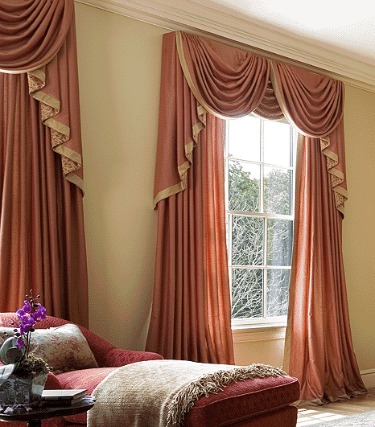 An example of excessively formal draperies. Great if you live in Buckingham Palace; not good for selling your home!
An example of excessively formal draperies. Great if you live in Buckingham Palace; not good for selling your home!Sadly, old-fashioned or overly ornate curtain styles can deter a home sale, causing buyers to think the entire house is outdated and rundown as well.
Theme-based window treatments, like “My Little Ponies” or “Disney” characters are too taste specific and won’t appeal to many people over the age of 10.
Wild patterns, animal prints and theme rooms are also buyer turnoffs.
Colors, patterns, and textures for windows
Avoid wildly patterned or garish-colored window coverings if you're selling your home. Neutral colors are best, because most people like them.
Decorate with neutral patterns like geometrics and stripes. They're usually stylish without being too taste specific.
Window coverings should complement the color and style in each room. Fabric that looks good on your furniture will also look good on windows.
A general design rule is to repeat a fabric two to three times in a room; on an upholstered chair, accent pillows and window dressings.
If you have customized window treatments that enhance your home decor, consider leaving them for the new home owners.
This is a great selling feature, plus it's one less thing you'll have to pack for your move! Chances are, they won't go with your new home anyway.
Like color, texture can greatly influence the mood in a room.
In general, smooth textures, (like silk or satin) the more formal a room will feel.
The reverse occurs with coarsely textured fabrics. Coarser textures absorb more light so colors will appear darker. Heavily brocaded draperies will look far heavier than silk drapes.
In the same manner as textures, heavily patterned fabrics can look weightier than solid colors, unless the solid color is dark.
It’s okay to simply leave windows bare— especially if the windows look out on a fantastic view!
Some windows can just be too pretty to cover, as well.
You don't want buyers to miss a stunning view, a lovely garden or a tempting outdoor living space.
If you're not sure how to dress a window, it’s better to leave them bare rather than having the wrong window treatments in place.
Window treatment styles that will sell your home
Curtains and drapes
Things to consider before you select your window dressings;
- What is the overall style of your home? Is it formal or casual?
- What is the interior lighting like? Is it too dark? Is privacy needed?
Tab-top curtains - these are a good choice for an informal, casual look. Curtain rods are threaded through the tabs and look best mounted outside the window frame.
Tie-top curtains - Tabs are tied directly to the curtain rod, giving them an informal look.
Tie-back curtains - These are simply curtains held back with fabric or cord ties.
Grommet-top curtains - Curtain rods are threaded through grommets at the top of the curtains, resulting in a clean, contemporary look.
Rod curtains - Curtain rods are shoved through a pocket sewn in the top of the curtain. This creates a straight, crisp look. Rod curtains can be mounted inside or outside window frames.
Valances - Window valances are horizontal decorative features that hang at the top of a window. They're often used to hide curtain rods. Valances can make a window seem taller when mounted on the wall ABOVE the window rather than on the window frame. Hanging a valance is a good way to add color or pattern to an otherwise bland room.
Window blinds and shades
Window shades and blinds are good choices for kitchens and bathrooms. If you are trying to sell your house, avoid window shades with overwhelming volumes of pleated or billowing fabrics, like balloon and Austrian styles. Instead try;
Pull-up blinds - Pull-up blinds create flat pleats as they're raised and typically look formal. Pull-up blinds can be mounted inside or outside of window casings. They can be pricey if you have to custom order to fit, because windows aren't a standard size..
Venetian blinds - Venetian blinds typically have 2" wide horizontal slats, usually made of aluminum. Other common materials are vinyl, plastic and wood. Venetian blinds are great for blocking an ugly view, yet still letting light in. Wood blinds look good in traditional rooms, whereas metal blinds have a contemporary vibe. Always leave blinds partly open when showing your house to allow light in.
Roll-up window blinds - Rollup blinds window blinds roll up from the bottom. They look best in a casual, contemporary space. Great for kid's rooms, kitchens, and bathrooms.
Roman shades - are an elegant and classy way to highlight your windows and control light. They have wide pleats and open up in an accordion-like fashion. Roman shades are straight and flat when unfolded, in the closed position. Roman shades are available in a variety of different fabrics and folding methods.
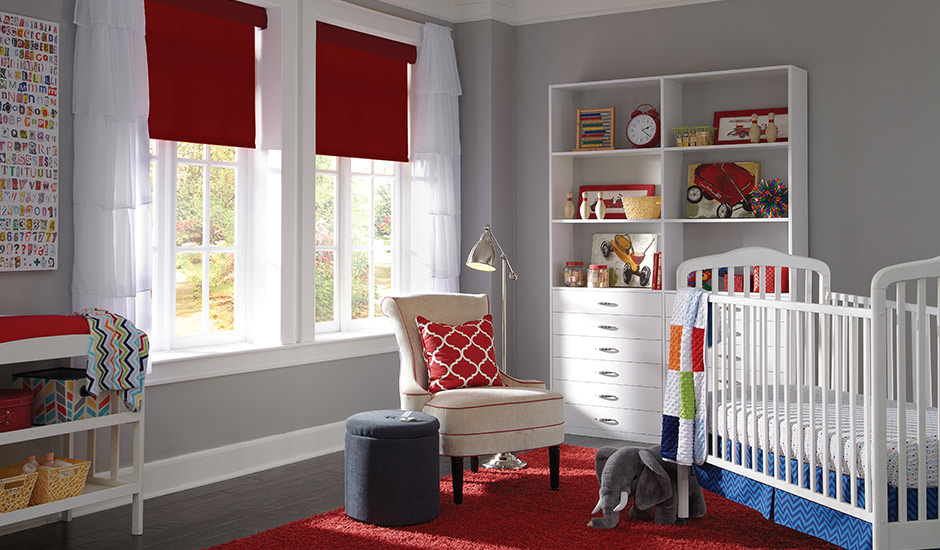 This adorable baby room is brightened by the red window shades and paired white curtains. Find these shades at budgetblinds.com
This adorable baby room is brightened by the red window shades and paired white curtains. Find these shades at budgetblinds.comRoller window shades - Roller shades lift up and down smoothly with a spring-roller mechanism— they conveniently adjust to any position. Very affordable and available in a wide variety of materials and typically covered with a plastic coating or fabric. Roller shades look best when combined with other forms of window treatments, like window curtains.
They are affordable and available in a wide variety of colors and materials. Roller shades look best when combined with other forms of window treatments, like curtains or drapes.
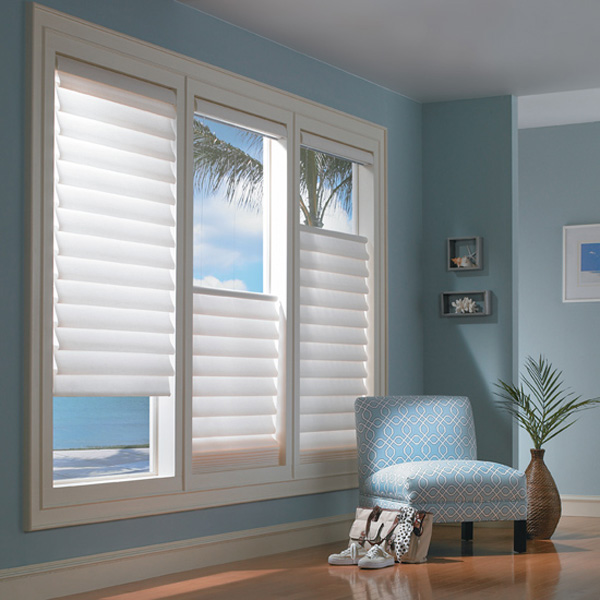 The great thing about shutters is that you can enjoy privacy and light simultaneously. Photo by architectureartdesigns.com
The great thing about shutters is that you can enjoy privacy and light simultaneously. Photo by architectureartdesigns.comShutters - Traditional-style shutters are louvered, which means they're angled to let in light. Most people love the way they look. The shutters in the photo above have a crisp, contemporary look.
How to hang curtain panels and drapes
The width of each panel should be 1 1/2 to 2 1/2 times the width of the window.
Treatments can be hung in two ways:
Curtains and drapes shouldn’t hang partway between the window sill and the floor. If you have a radiator or air conditioner in the way under a window, hang curtains at the windowsill. A full length curtain touching a base board heater won’t hang right and may be a fire hazard.
Floor length curtains should break at the floor about an inch or two to create an elegant drape.
If floor length curtains will be opened and closed daily, a 1/4 to 1/2 inch clearance at the floor will allow them to operate smoothly.
If you want to go for the elegant puddled look, (where extra curtain fabric is gracefully arranged on the floor) the allowances are 6 to 9 inches.
Short curtains that fit inside the window sill should sit at the windowsill. Curtains that fall outside the window sill should fall at the window sill. Shorter curtains shouldn't hang partway between the sill and the floor.
How to select the right window hardware
Curtain rods are made from a variety of products; metal, wood and plastic. I've seen curtain rods made from tree branches, an oar, a hockey stick, an antler, and a piece of bamboo! If you have a house for sale, keep it simple-- don’t be too taste specific.
After taking down old window coverings, you'll be left with ugly holes in the walls from the hardware. Fill the holes with spackling paste or another product called "erase-a-hole."
Stay away from outdated thick clunky rods with large finials and fat rings. Select an updated, curtain rod in a thinner style, but substantial enough to make the window important.
For really wide windows, you’ll need at least one center support bracket, maybe two depending upon how wide the window is and how much weight the rod will have to bear.
Please don’t put holes in beautiful window molding, especially if the house is historic. It’s often best (and easiest!) to leave the windows bare to show off the trim work. If you must have window coverings for privacy, mount the hardware outside the window frame.
Choose the appropriate wall anchors for hanging rod brackets. Don’t use screws and wall anchors that come in the little packages with the curtain rods when you buy them. They're usually cheap, break easily, and the screw heads strip out. Ask a hardware store worker to help you pick out good quality wall anchors and screws.
Try Kwik-hang to get your curtains up in a hurry!
I wish Kwik-hang had been around years ago when I used to hang a lot of curtains and drapes. No need to worry about ruining sheetrock or fussing with drywall anchors.
Kwik-hang holds up to 20 lbs. and comes in five color options; black, silver, brass, white and bronze.
This product is available at Kwikhang.com, Bed Bath and Beyond, Walmart, and of course, Amazon.
Watch this video to see just how easy it is to hang curtains! Video by Kwik-hang.
Window treatments for problem areas
- To make low ceilings appear higher, hang curtain rods close to the ceiling instead of just above the window frame. Use full length curtains that hang to the floor. This will add a longer vertical element to the room, making ceilings seem higher.
- To widen a narrow window and allow more light in, use a rod that extends beyond the frame. With curtains pulled back, more of the window will show, making the window seem wider. Be sure edges of the window frame don’t show, or the illusion won't work.
- To make a window appear taller, install the rod a few inches higher than the frame. Add a valance to cover the gap between the rod and frame.
- Ceilings and windows appear taller when using drapes with vertical stripes or patterns.
- To make a window appear shorter, install a valance on the frame instead of the wall. The valance will cover part of the window, making it seem shorter.
- If a window is off-center with little or no wall space on one side, hang a rod and curtain across the entire window and swag the curtain toward the side with more wall space. This will draw the eye away from the off-centered side.
- For windows situated in an awkward place, use curtains the same color as the walls. It'll be less noticeable that way.
- Hang sheers to block out an ugly view. They'll soften the view, yet filter light in.
- Apply frosted window film to small windows where you need privacy, as in a front door. Frosted window film lets light in, is easy to apply and is removable!
- To find, go to gilafilms.com, windowfilmandmore.com, or artscape-inc.com. Also available at Amazon, Lowes, and most home supply centers.
- If you want to direct a buyer’s attention to a great view outside, hang curtains that're the same color as the wall. This will give the illusion of more space in a room as well.
- Consider the mood you want to create in each room. For instance, if you're going for an elegant feel in the master bedroom, stage it with window coverings made from luxurious and smooth fabrics.
- In tiny rooms, don't overwhelm the space with oppressive window treatments.
- For large rooms, use window coverings that'll complement that grander feel.
Return from window treatments to home page
Updated 1-18-2024
